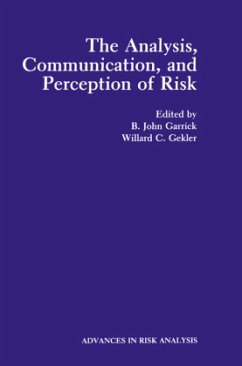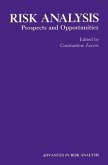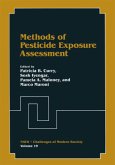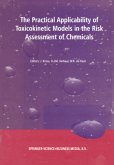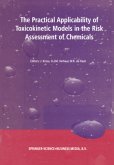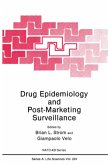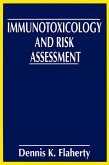B.John Garrick / Willard C. Gekler (eds.)
The Analysis, Communication, and Perception of Risk
Herausgegeben:Garrick, B.John; Gekler, Willard C.
B.John Garrick / Willard C. Gekler (eds.)
The Analysis, Communication, and Perception of Risk
Herausgegeben:Garrick, B.John; Gekler, Willard C.
- Gebundenes Buch
- Merkliste
- Auf die Merkliste
- Bewerten Bewerten
- Teilen
- Produkt teilen
- Produkterinnerung
- Produkterinnerung
The 1989 Annual Meeting of the Society for Risk Analysis dramatically demonstrated one of the most important reasons for having the Society - to bring together people with highly diverse backgrounds and disciplines to assess the common problems of societal and individual risks. The physical scientists emphasized the analytical tools for assessing environmental effects and for modeling risks from engineered systems and other human activities. The health scientists presented numerous methods of analyzing health effects, including the subject of dose-response relationships, especially at low…mehr
Andere Kunden interessierten sich auch für
![Risk Analysis Risk Analysis]() Constantine Zervos / Kathleen Knox / Lee Abramson / Rob Coppock (eds.)Risk Analysis243,99 €
Constantine Zervos / Kathleen Knox / Lee Abramson / Rob Coppock (eds.)Risk Analysis243,99 €![Methods of Pesticide Exposure Assessment Methods of Pesticide Exposure Assessment]() Patricia B. Curry / Sesh Iyengar / Pamela A. Maloney / M. Maroni (Hgg.)Methods of Pesticide Exposure Assessment161,99 €
Patricia B. Curry / Sesh Iyengar / Pamela A. Maloney / M. Maroni (Hgg.)Methods of Pesticide Exposure Assessment161,99 €![New Risks: Issues and Management New Risks: Issues and Management]() Louis A. Cox / Paolo F. Ricci (eds.)New Risks: Issues and Management243,99 €
Louis A. Cox / Paolo F. Ricci (eds.)New Risks: Issues and Management243,99 €![The Practical Applicability of Toxicokinetic Models in the Risk Assessment of Chemicals The Practical Applicability of Toxicokinetic Models in the Risk Assessment of Chemicals]() The Practical Applicability of Toxicokinetic Models in the Risk Assessment of Chemicals112,99 €
The Practical Applicability of Toxicokinetic Models in the Risk Assessment of Chemicals112,99 €![The Practical Applicability of Toxicokinetic Models in the Risk Assessment of Chemicals The Practical Applicability of Toxicokinetic Models in the Risk Assessment of Chemicals]() J. Krüse / H. Verhaar / W.K. de Raat (Hgg.)The Practical Applicability of Toxicokinetic Models in the Risk Assessment of Chemicals121,99 €
J. Krüse / H. Verhaar / W.K. de Raat (Hgg.)The Practical Applicability of Toxicokinetic Models in the Risk Assessment of Chemicals121,99 €![Drug Epidemiology and Post-Marketing Surveillance Drug Epidemiology and Post-Marketing Surveillance]() Brian L. Strom / G.P Velo (Hgg.)Drug Epidemiology and Post-Marketing Surveillance121,99 €
Brian L. Strom / G.P Velo (Hgg.)Drug Epidemiology and Post-Marketing Surveillance121,99 €![Immunotoxicology and Risk Assessment Immunotoxicology and Risk Assessment]() Dennis K. FlahertyImmunotoxicology and Risk Assessment161,99 €
Dennis K. FlahertyImmunotoxicology and Risk Assessment161,99 €-
-
-
The 1989 Annual Meeting of the Society for Risk Analysis dramatically demonstrated one of the most important reasons for having the Society - to bring together people with highly diverse backgrounds and disciplines to assess the common problems of societal and individual risks. The physical scientists emphasized the analytical tools for assessing environmental effects and for modeling risks from engineered systems and other human activities. The health scientists presented numerous methods of analyzing health effects, including the subject of dose-response relationships, especially at low exposure levels - never an easy analysis. The social and political scientists concentrated on issues of risk perception, communication, acceptability, and human touch. Others discussed such issues as cost-benefit analysis and the risk-based approach to decision analysis. Use of risk assessment methods for risk management continued to be a matter of strong opinion and debate. The impacts of stateand federal regulations, existing and planned, were assessed in sessions and in luncheon speeches. These impacts show that risk analysis practitioners will have an increasingly important role in the future. They will be challenged to provide clear, easily understood evaluations of risk that are responsive to society's concern for risk, as evidenced in laws and regulations. Of course, the various risk analysis specialties overlapped in domains of interest.
Hinweis: Dieser Artikel kann nur an eine deutsche Lieferadresse ausgeliefert werden.
Hinweis: Dieser Artikel kann nur an eine deutsche Lieferadresse ausgeliefert werden.
Produktdetails
- Produktdetails
- Advances in Risk Analysis 9
- Verlag: Springer, Berlin
- 1991.
- Seitenzahl: 732
- Erscheinungstermin: 30. April 1991
- Englisch
- Abmessung: 260mm x 183mm x 45mm
- Gewicht: 1588g
- ISBN-13: 9780306438332
- ISBN-10: 030643833X
- Artikelnr.: 23035749
- Herstellerkennzeichnung Die Herstellerinformationen sind derzeit nicht verfügbar.
- Advances in Risk Analysis 9
- Verlag: Springer, Berlin
- 1991.
- Seitenzahl: 732
- Erscheinungstermin: 30. April 1991
- Englisch
- Abmessung: 260mm x 183mm x 45mm
- Gewicht: 1588g
- ISBN-13: 9780306438332
- ISBN-10: 030643833X
- Artikelnr.: 23035749
- Herstellerkennzeichnung Die Herstellerinformationen sind derzeit nicht verfügbar.
Uncertain Temporal Logics for Risk Analysis.- Individual Differences in Risk Perception and Risk-Taking Preferences.- Technological Risk Perception: Similarities and Dissimilarities in French and American Samples.- Risk Perception and Energy Policy: A Swedish Case Study.- Dispersion of Dense Air Toxics.- Carpet/4-Phenylcyclohexene Toxicity: The EPA Headquarters Case.- Analysis of Community Risk Resulting from Rupture of a Sour Gas Pipeline.- Risk Assessment for Children Playing on Lawns Treated with a Pesticide.- Uncertainty Management in Engineering Risk Assessment.- An Approach to the Analysis of Accident Precursors.- Risk Perception and the Politics of Citizen Participation: The Case of Radioactive Waste Management.- Screening Lifetime Risks to Help Prevent Radon Exposure: A Methodology for Public Health Policy Makers.- Dose-Response Relationship Between Arsenic Inhalation Exposure and Risk of Lung Cancer.- Development of Uncertainty Factors for Nonhuman Receptors.- Addressing Uncertainties in Environmental Site Audits.- Farmworkers and Pesticide Exposure: Perceived Risk and Self-Protective Behavior.- Age-Dependent Risk Quantification Using Standard Maintenance Records.- Use of Risk Analysis on Remedial Alternatives.- Victims, Agents, and Outrage.- An Introduction to the Texas Risk Communication Process.- Risk Communication and the Cognitive Representation of Uncertainty.- Common Methodological Flaws in Risk Assessment.- Use of Risk Assessment Methodologies for Sewage Sludge Disposal Regulations.- Presentation of Risk Assessments of Carcinogens.- Exposure to Environmental Contaminants Through Breast Milk.- Cancer Risk from the Application of Newspaper to Farmland.- Alar in Fruit: Limited Regulatory Action in the Face of Uncertain Risks.- Extending Biologically-BasedCancer Risk Modeling to Apply to Benzene-Induced Leukemogenesis.- Reducing the Risk in Buying Risk Analysis Software.- Probabilistic Causality and Its Applications to Risk Analysis.- A Comprehensive Risk Analysis Example.- Public Perception and Response to the Parkfield California Earthquake Prediction.- Preliminary Analysis of Off-Normal Emissions from a Hazardous Waste Incinerator.- Estimating Emissions from Municipal Solid Waste Incinerators.- The Role of Structure-Activity Relationships in Risk Assessment.- A Framework for Computer Security Risk Management.- The Rules of the Game: What Recent Rulings Say About Courts' and Regulators' Differing Approaches to Establishing Causation for Chronic Health Risks.- Determinants of Severity in Acutely Hazardous Chemical Releases.- The 1988 Ashland Oil Spill: Lessons Learned Regarding Emergency Response Planning for Hazmat Releases.- Potential Uses and Abuses of Toxic Release Inventory Data.- Robust Estimation of Lung Retention in Animals Exposed to a-Emitting Radionuclides.- Dispositional Differences of 2, 3, 7, S-Tetrachlorodibenzo-p-dioxin in Rats and Humans: Implications in Cancer Mechanisms and Risk Assessment.- The Risk Analysis of Extreme Events in Queuing Theory.- On the Inclusion of Organizational and Managerial Influences in Probabilistic Safety Assessments of Nuclear Power Plants.- Risk Communication and Regulatory Culture Clash.- Bridging the Gap Between Risk Assessment by Professionals and Acceptance by Lay Decision Makers.- Acceptability of Risk: Vinyl Chloride and RCRA Subtitle D, Potential Decision Framework.- Consistent Estimates of Urethane Carcinogenic Potency Using Pharmacokinetic and Time-Dependent Models.- Carcinogenic Impurities in Food and Color Additives-An Analysis of Presumptive Risk Levels.-Decision Theory, Failure Tolerance Analysis, and Quantitative Risk Analysis -Synergistic Application to the Space Station Freedom WP-2 Program.- Sources and Consequences of Hypothetical Bias in Economic Analyses of Risk Behavior.- Establishing Communication with Brookhurst: A Case Study in Community Involvement.- Accepting New Technology: Community Relations for Mobile Incineration in Illinois.- Evaluation of Analytical Methods in Water for the Chemicals Listed Under the California Safe Drinking Water and Toxic Enforcement Act of 1986 (Proposition 65).- Use of Health Risk Estimates in U.S. EPA Activities.- The Use of Quantitative Risk Assessment in the Continuing Risk Management of a Chlorine Handling Facility.- Ozone Risk Assessment Implementation: Transferring Risk Analysis Technology to Ozone Nonattainment Planning.- Acute Ozone Exposure-Response Relationships for Use in Health Risk Assessment.- Risk-Benefit Balancing in Risk Management: Measures of Benefits and Detriments.- Risk Assessment of Soil-Related Foundation Failure.- Estimating Mine Equipment Injury Rates.- Ecological Models for Risk Assessment/Risk Management.- Science Quality and Risk Assessment: The Leaking Landfill.- Risk Assessment-Risk Management: The Need for a Synthesis.- Application of an Urban-Scale Population Exposure Model (NEM/SAI) to Ozone Exposure Assessment.- New Approaches and Tools for Quantitative Cancer Risk Assessment.- Statistical Properties of a Model-Free Approach to Low-Dose Extrapolation.- Author Index.
Uncertain Temporal Logics for Risk Analysis.- Individual Differences in Risk Perception and Risk-Taking Preferences.- Technological Risk Perception: Similarities and Dissimilarities in French and American Samples.- Risk Perception and Energy Policy: A Swedish Case Study.- Dispersion of Dense Air Toxics.- Carpet/4-Phenylcyclohexene Toxicity: The EPA Headquarters Case.- Analysis of Community Risk Resulting from Rupture of a Sour Gas Pipeline.- Risk Assessment for Children Playing on Lawns Treated with a Pesticide.- Uncertainty Management in Engineering Risk Assessment.- An Approach to the Analysis of Accident Precursors.- Risk Perception and the Politics of Citizen Participation: The Case of Radioactive Waste Management.- Screening Lifetime Risks to Help Prevent Radon Exposure: A Methodology for Public Health Policy Makers.- Dose-Response Relationship Between Arsenic Inhalation Exposure and Risk of Lung Cancer.- Development of Uncertainty Factors for Nonhuman Receptors.- Addressing Uncertainties in Environmental Site Audits.- Farmworkers and Pesticide Exposure: Perceived Risk and Self-Protective Behavior.- Age-Dependent Risk Quantification Using Standard Maintenance Records.- Use of Risk Analysis on Remedial Alternatives.- Victims, Agents, and Outrage.- An Introduction to the Texas Risk Communication Process.- Risk Communication and the Cognitive Representation of Uncertainty.- Common Methodological Flaws in Risk Assessment.- Use of Risk Assessment Methodologies for Sewage Sludge Disposal Regulations.- Presentation of Risk Assessments of Carcinogens.- Exposure to Environmental Contaminants Through Breast Milk.- Cancer Risk from the Application of Newspaper to Farmland.- Alar in Fruit: Limited Regulatory Action in the Face of Uncertain Risks.- Extending Biologically-BasedCancer Risk Modeling to Apply to Benzene-Induced Leukemogenesis.- Reducing the Risk in Buying Risk Analysis Software.- Probabilistic Causality and Its Applications to Risk Analysis.- A Comprehensive Risk Analysis Example.- Public Perception and Response to the Parkfield California Earthquake Prediction.- Preliminary Analysis of Off-Normal Emissions from a Hazardous Waste Incinerator.- Estimating Emissions from Municipal Solid Waste Incinerators.- The Role of Structure-Activity Relationships in Risk Assessment.- A Framework for Computer Security Risk Management.- The Rules of the Game: What Recent Rulings Say About Courts' and Regulators' Differing Approaches to Establishing Causation for Chronic Health Risks.- Determinants of Severity in Acutely Hazardous Chemical Releases.- The 1988 Ashland Oil Spill: Lessons Learned Regarding Emergency Response Planning for Hazmat Releases.- Potential Uses and Abuses of Toxic Release Inventory Data.- Robust Estimation of Lung Retention in Animals Exposed to a-Emitting Radionuclides.- Dispositional Differences of 2, 3, 7, S-Tetrachlorodibenzo-p-dioxin in Rats and Humans: Implications in Cancer Mechanisms and Risk Assessment.- The Risk Analysis of Extreme Events in Queuing Theory.- On the Inclusion of Organizational and Managerial Influences in Probabilistic Safety Assessments of Nuclear Power Plants.- Risk Communication and Regulatory Culture Clash.- Bridging the Gap Between Risk Assessment by Professionals and Acceptance by Lay Decision Makers.- Acceptability of Risk: Vinyl Chloride and RCRA Subtitle D, Potential Decision Framework.- Consistent Estimates of Urethane Carcinogenic Potency Using Pharmacokinetic and Time-Dependent Models.- Carcinogenic Impurities in Food and Color Additives-An Analysis of Presumptive Risk Levels.-Decision Theory, Failure Tolerance Analysis, and Quantitative Risk Analysis -Synergistic Application to the Space Station Freedom WP-2 Program.- Sources and Consequences of Hypothetical Bias in Economic Analyses of Risk Behavior.- Establishing Communication with Brookhurst: A Case Study in Community Involvement.- Accepting New Technology: Community Relations for Mobile Incineration in Illinois.- Evaluation of Analytical Methods in Water for the Chemicals Listed Under the California Safe Drinking Water and Toxic Enforcement Act of 1986 (Proposition 65).- Use of Health Risk Estimates in U.S. EPA Activities.- The Use of Quantitative Risk Assessment in the Continuing Risk Management of a Chlorine Handling Facility.- Ozone Risk Assessment Implementation: Transferring Risk Analysis Technology to Ozone Nonattainment Planning.- Acute Ozone Exposure-Response Relationships for Use in Health Risk Assessment.- Risk-Benefit Balancing in Risk Management: Measures of Benefits and Detriments.- Risk Assessment of Soil-Related Foundation Failure.- Estimating Mine Equipment Injury Rates.- Ecological Models for Risk Assessment/Risk Management.- Science Quality and Risk Assessment: The Leaking Landfill.- Risk Assessment-Risk Management: The Need for a Synthesis.- Application of an Urban-Scale Population Exposure Model (NEM/SAI) to Ozone Exposure Assessment.- New Approaches and Tools for Quantitative Cancer Risk Assessment.- Statistical Properties of a Model-Free Approach to Low-Dose Extrapolation.- Author Index.

